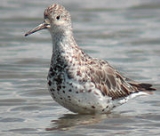
Great Knot
Encyclopedia
The Great Knot, Calidris tenuirostris, is a small wader
. It is the largest of the calidrid
species.
Their breeding habitat is tundra
in northeast Siberia
. They nest on the ground laying about four eggs in a ground scrape. They are strongly migratory
wintering on coasts in southern Asia through to Australia. This species forms enormous flocks in winter. It is a rare vagrant
to western Europe.
This species has short dark legs and a medium-length thin dark bill. Breeding adults have mottled greyish upperparts with some rufous feathering. The face, throat and breast are heavily spotted black, and there are also some streaks on the rear belly. In winter the plumage becomes uniformly pale grey above.
This bird is closely related to the more widespread Red Knot
. In breeding plumage, the latter has a distinctive red face, throat and breast. In other plumages, the Great Knot can be identified by its larger size, longer bill, deeper chest, and the more streaked upperparts.
These birds forage on mudflats and beaches, probing or picking up food by sight. They mainly eat molluscs and insects.
The Great Knot is one of the species to which the Agreement on the Conservation of African-Eurasian Migratory Waterbirds (AEWA
) applies.
.
Wader
Waders, called shorebirds in North America , are members of the order Charadriiformes, excluding the more marine web-footed seabird groups. The latter are the skuas , gulls , terns , skimmers , and auks...
. It is the largest of the calidrid
Calidrid
The calidrids or typical waders are a group of Arctic-breeding, strongly migratory wading birds. These birds form huge mixed flocks on coasts and estuaries in winter. They are the typical "sandpipers", small to medium-sized, long-winged and relatively short-billed.Their bills have sensitive tips...
species.
Their breeding habitat is tundra
Tundra
In physical geography, tundra is a biome where the tree growth is hindered by low temperatures and short growing seasons. The term tundra comes through Russian тундра from the Kildin Sami word tūndâr "uplands," "treeless mountain tract." There are three types of tundra: Arctic tundra, alpine...
in northeast Siberia
Siberia
Siberia is an extensive region constituting almost all of Northern Asia. Comprising the central and eastern portion of the Russian Federation, it was part of the Soviet Union from its beginning, as its predecessor states, the Tsardom of Russia and the Russian Empire, conquered it during the 16th...
. They nest on the ground laying about four eggs in a ground scrape. They are strongly migratory
Bird migration
Bird migration is the regular seasonal journey undertaken by many species of birds. Bird movements include those made in response to changes in food availability, habitat or weather. Sometimes, journeys are not termed "true migration" because they are irregular or in only one direction...
wintering on coasts in southern Asia through to Australia. This species forms enormous flocks in winter. It is a rare vagrant
Vagrancy (biology)
Vagrancy is a phenomenon in biology whereby individual animals appear well outside their normal range; individual animals which exhibit vagrancy are known as vagrants. The term accidental is sometimes also used...
to western Europe.
This species has short dark legs and a medium-length thin dark bill. Breeding adults have mottled greyish upperparts with some rufous feathering. The face, throat and breast are heavily spotted black, and there are also some streaks on the rear belly. In winter the plumage becomes uniformly pale grey above.
This bird is closely related to the more widespread Red Knot
Red Knot
The Red Knot, Calidris canutus , is a medium sized shorebird which breeds in tundra and the Arctic Cordillera in the far north of Canada, Europe, and Russia. It is a large member of the Calidris sandpipers, second only to the Great Knot...
. In breeding plumage, the latter has a distinctive red face, throat and breast. In other plumages, the Great Knot can be identified by its larger size, longer bill, deeper chest, and the more streaked upperparts.
These birds forage on mudflats and beaches, probing or picking up food by sight. They mainly eat molluscs and insects.
The Great Knot is one of the species to which the Agreement on the Conservation of African-Eurasian Migratory Waterbirds (AEWA
AEWA
The Agreement on the Conservation of African-Eurasian Migratory Waterbirds is the largest of its kind developed so far under the Bonn Convention. It was concluded on 16 June 1995 at The Hague, the Netherlands and entered into force on 1 November 1999 after the required number of at least fourteen...
) applies.
Australia
Great Knot are not listed as threatened on the Environment Protection and Biodiversity Conservation Act 1999Environment Protection and Biodiversity Conservation Act 1999
The Environment Protection and Biodiversity Conservation Act 1999 is an Act of the Parliament of Australia that provides a framework for protection of the Australian environment, including its biodiversity and its natural and culturally significant places...
.
State of Victoria, Australia
- Great Knot are listed as threatened on the Victorian Flora and Fauna Guarantee Act (1988). Under this Act, an Action Statement for the recovery and future management of this species has not been prepared.
- On the 2007 advisory list of threatened vertebrate fauna in Victoria, this species is listed as endangered.
External links
- Oiseaux Photos

